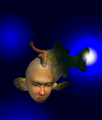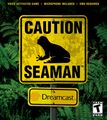Seaman
From Sega Retro

| ||||||||||||||||||||
| Seaman | ||||||||||||||||||||
|---|---|---|---|---|---|---|---|---|---|---|---|---|---|---|---|---|---|---|---|---|
| System(s): Sega Dreamcast | ||||||||||||||||||||
| Publisher: Vivarium (Japan), Sega (US) | ||||||||||||||||||||
| Developer: Vivarium | ||||||||||||||||||||
| Peripherals supported: Dreamcast VGA Box, Visual Memory Unit, Dreamcast Microphone | ||||||||||||||||||||
| Genre: Simulation[1] | ||||||||||||||||||||
| Number of players: 1 | ||||||||||||||||||||
|
Seaman, called Seaman: Kindan no Pet (シーマン 〜禁断のペット〜) in Japan, is a video game developed by Vivarium for the Sega Dreamcast in 1999. The game was later ported to the PlayStation 2 in 2001.
Contents
Gameplay
Seaman's face is that of Yoot Saito, the leading man behind Vivarium.
History
It debuted with the Dreamcast Microphone, which was bundled with the game. The game was not released in Europe (plans were once in place to release it there in 2001), though the Microphone accessory was (Planet Ring being the only game released in that region to be compatible with the peripheral).
Japanese consumers also had an option to buy a "Special Package" bundle, which as well as including the game and microphone, also included a clear VMU (as the game requires one to function).
120,000 copies of the game were sold in Japan in the first three weeks of sale[2].
Legacy
For a while after its release, Seaman was the best-selling Dreamcast game in Japan, beating Sonic Adventure and SoulCalibur[3]. Famitsu sales charts compiled until early 2004 show it as the third highest-selling Dreamcast game of all-time in that region[4].
Sequels/updates Christmas Seaman and Seaman 2001 were released in Japan, and the game was also followed by a PlayStation 2 sequel, Seaman 2.
Production credits
- Produced & Game Designed By: Yoot Saito
- Development Directed By: Satoshi Endo, Arka Roy
- Graphics Directed By: Atsushi Hotta
- Programings By: Kazuhiko Sugita, Tak Suzuki, Shigekazu Ito, Yoshito Hirose
- Graphics by: Tomomasa Ueda, Bujin Hirai, Nobuyuki Usuki, Koichi Okada
- Graphics by: Minoru Urano, Yoko Shibusawa, Yiting Fu, Cozzy Sumitomo, Makoto Iwanaga
- Narrations By: Toshiyuki Hosokawa
- Musics By: Trans Global Underground
- Developed by: Vivarium Inc
- Presented & Copyrights All Reserved By: Digitoys Co.,Ltd
- See You In Seaman2001
- Producer and Game Designer: Yoot Saito
- US Development Director: Arka Roy
- US Script Programming Team: Seppo Helava, Chris Craig, Alex Genadinik
- Narrator: Leonard Nimoy
- Casting and Recording: Webtone
- Localization Producers: Mari N. Schaal, Osamu Shibamiya
- Test Lead: Steve Peck
- Assistant Test Leads: Rick Ribble Jr., Bob Homan
- Music: Trans Global Underground (UK)
- Product Marketing: Stacey Kerr, John Golden
- Creative Services: Robert Schonfisch
- PR: Heather Hawkins
- Assistants to Mr. Seaman (Jellyvision, Inc.): Brian Chard, Kate Powers, Lina Chern, Amy Lippa, Shannon Miller, Mike Brumm, Steve Newman, Jeremy Hornik, Traci Todd
- Special Thanks: Buzzy's Recording, June Honma, Dylan Bromley, Klayton Vorlick, Toshiro Kezuka, Will Wright, Greg & Kim Weber, Liz Michaels, Jason Kuo, Hiroaki Ohmura, Jim Yamashita, Sandra Castagnola, Jin Shimazaki, Shinobu Toyoda
- Translator/Writer/DTP: Monika Hudgins
- Supervisor: Kaoru Ichigozaki
- DTP Advisors: Yoshihiro Sakuta, Osamu Nakazato, Eiichi Ogawa
- Producer and Game Designer: Yoot Saito
- System Designer: Aka Roy
- Director: Satoshi Endo
- Art Director: Atsushi Hotta
- Programmers: Kazuhiko Sugita, Takahisa Suzuki, Shigekazu Ito, Yoshito Hirose
- Sound: Tsuneo Kaneda
- Graphic Artists: Makoto Iwanagawa, Tomomasa Ueda, Nobuyuki Usuki, Minoru Urano, Koichi Okada, Yoko Shibusawa, Bujin Hirai, Yiting Fu, Cozzy Sumitomo
- Assistant Programmers: Ryo Takeishi, Makoto Fukuichi, Tomomi Hiramatsu
- All trademarks are the property of their respective owners.
- "WIFFLE" is a registered trademark of The Wiffle Ball, Inc. and is used with permission.
Magazine articles
- Main article: Seaman/Magazine articles.
Promotional material
also published in:
- Dreamcast Magazine (JP) #1999-24: "1999-24 (1999-08-06)" (1999-07-23)[5]
also published in:
- GamePro (US) #143: "August 2000" (2000-0x-xx)[6]
- Electronic Gaming Monthly (US) #134: "September 2000" (2000-08-08)[7]
Artwork
Physical scans
| Sega Retro Average | |||||||||||||||||||||||||||||||||||||||||||||||||||||||||||||||||||||||||||||||
|---|---|---|---|---|---|---|---|---|---|---|---|---|---|---|---|---|---|---|---|---|---|---|---|---|---|---|---|---|---|---|---|---|---|---|---|---|---|---|---|---|---|---|---|---|---|---|---|---|---|---|---|---|---|---|---|---|---|---|---|---|---|---|---|---|---|---|---|---|---|---|---|---|---|---|---|---|---|---|---|
|
| 79 | |
|---|---|
| Based on 15 reviews | |
Technical information
ROM dump status
| System | Hash | Size | Build Date | Source | Comments |
|---|
External links
- Sega of Japan catalogue pages (Japanese): Dreamcast
References
- ↑ 1.0 1.1 1.2 1.3 1.4 http://sega.jp/dc/990401/ (Wayback Machine: 2007-12-09 07:34)
- ↑ Edge, "October 1999" (UK; 1999-09-06), page 148
- ↑ Electronic Gaming Monthly, "June 2000" (US; 2000-05-09), page 30
- ↑ http://www.japan-gamecharts.com:80/dc.php (Wayback Machine: 2008-08-21 06:06)
- ↑ Dreamcast Magazine, "1999-24 (1999-08-06)" (JP; 1999-07-23), page 74
- ↑ GamePro, "August 2000" (US; 2000-0x-xx), page 40
- ↑ Electronic Gaming Monthly, "September 2000" (US; 2000-08-08), page 136
- ↑ DC-UK, "December 2000" (UK; 2000-10-23), page 80/81 (80)
- ↑ 9.0 9.1 Dreamcast Magazine, "1999-24 (1999-08-06)" (JP; 1999-07-23), page 19
- ↑ 10.0 10.1 Dorimaga, "2002-18 (2002-10-11)" (JP; 2002-09-27), page 34
- ↑ 11.0 11.1 Edge, "October 2000" (UK; 2000-09-11), page 103
- ↑ Ação Games, "Janeiro 2001" (BR; 200x-xx-xx), page 36
- ↑ DC-UK, "December 2000" (UK; 2000-10-23), page 80
- ↑ Dreamcast Magazine, "No. 14" (UK; 2000-10-05), page 78
- ↑ Electronic Gaming Monthly, "September 2000" (US; 2000-08-08), page 155
- ↑ Entsiklopediya igr dlya Dreamcast, "Izdaniye chetvertoye, dopolnennoye" (RU; 2002-xx-xx), page 198
- ↑ Famitsu, "1999-08-06" (JP; 1999-07-23), page 30
- ↑ GamePro, "September 2000" (US; 2000-0x-xx), page 106
- ↑ Gamers' Republic, "August 2000" (US; 2000-xx-xx), page 64
- ↑ Next Generation, "September 2000" (US; 2000-08-15), page 106
- ↑ Power Unlimited, "Jaargang 09, Nummer 7, Juli 2001" (NL; 2001-0x-xx), page 61
- ↑ Strana Igr, "Sentyabr 2000 1/2" (RU; 2000-xx-xx), page 58
- ↑ Video Games, "10/2000" (DE; 2000-09-06), page 122
- No title screen
- Dreamcast Microphone-compatible games
- Dreamcast VGA Box-compatible games
- Visual Memory Unit-compatible games
- 1 player games
- JP Dreamcast games
- All JP games
- US Dreamcast games
- All US games
- Dreamcast games
- 1999 Dreamcast games
- All 1999 games
- Dreamcast simulation games
- All simulation games
- All games
- Credits without reference
- Old-style rating (dcuk)
- Old-style rating (dmjp)
- Old-style rating (dmjp r)
- Old-style rating (edge)
- Old-style rating (famitsu)
- Rating without PDF source
- Update ratings template
- 5 old ratings
- No ROM dumps
- Missing ROM dumps
- Old technical information
















